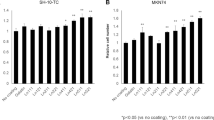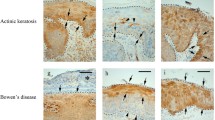Abstract
Squamous cell carcinoma is a prevalent head and neck tumor with high mortality. We studied the role played by laminin α1 chain peptide AG73 on migration, invasion, and protease activity of cells (OSCC) from human oral squamous cell carcinoma. Immunohistochemistry and immunofluorescence analyzed expression of laminin α1 chain and MMP9 in oral squamous cells carcinoma in vivo and in vitro. Migratory activity of AG73-treated OSCC cells was investigated by monolayer wound assays and in chemotaxis chambers. AG73-induced invasion was assessed in Boyden chambers. Invasion depends on MMPs. Conditioned media from cells grown on AG73 was subjected to zymography. We searched for AG73 receptors related to these activities in OSCC cells. Immunofluorescence analyzed AG73-induced colocalization of syndecan-1 and β1 integrin. Cells had these receptors silenced by siRNA, followed by treatment with AG73 and analysis of migration, invasion, and protease activity. Oral squamous cell carcinoma expresses laminin α1 chain and MMP9. OSCC cells treated with AG73 showed increased migration, invasion, and protease activity. AG73 induced colocalization of syndecan-1 and β1 integrin. Knockdown of these receptors decreased AG73-dependent migration, invasion, and protease activity. Syndecan-1 and β1 integrin signaling downstream of AG73 regulate migration, invasion, and MMP production by OSCC cells.







Similar content being viewed by others
References
McDowell JD. An overview of epidemiology and common risk factors for oral squamous cell carcinoma. Otolaryngol Clin North Am. 2006;39:277–94.
Mehrotra R, Yadav S. Oral squamous cell carcinoma: etiology, pathogenesis and prognostic value of genomic alterations. Indian J Cancer. 2006;43:60–6.
Bsoul SA, Huber MA, Terezhalmy GT. Squamous cell carcinoma of the oral tissues: a comprehensive review for oral healthcare providers. J Contemp Dent Pract. 2005;6:1–16.
Atula T, Hedstrom J, Finne P, Leivo I, Markkanen-Leppanen M, Haglund C. Tenascin-c expression and its prognostic significance in oral and pharyngeal squamous cell carcinoma. Anticancer Res. 2003;23:3051–6.
de Vicente JC, Fresno MF, Villalain L, Vega JA, Lopez Arranz JS. Immunoexpression and prognostic significance of timp-1 and -2 in oral squamous cell carcinoma. Oral Oncol. 2005;41:568–79.
Kellermann MG, Sobral LM, da Silva SD, Zecchin KG, Graner E, Lopes MA, et al. Myofibroblasts in the stroma of oral squamous cell carcinoma are associated with poor prognosis. Histopathology. 2007;51:849–53.
Comoglio PM, Trusolino L. Cancer: the matrix is now in control. Nat Med. 2005;11:1156–9.
Kleinman HK, Weeks BS, Schnaper HW, Kibbey MC, Yamamura K, Grant DS. The laminins: a family of basement membrane glycoproteins important in cell differentiation and tumor metastases. Vitam Horm. 1993;47:161–86.
Capuano AC, Jaeger RG. The effect of laminin and its peptide sikvav on a human salivary gland myoepithelioma cell line. Oral Oncol. 2004;40:36–42.
de Oliveira PT, Jaeger MM, Miyagi SP, Jaeger RG. The effect of a reconstituted basement membrane (matrigel) on a human salivary gland myoepithelioma cell line. Virchows Arch. 2001;439:571–8.
Freitas VM, Jaeger RG. The effect of laminin and its peptide sikvav on a human salivary gland adenoid cystic carcinoma cell line. Virchows Arch. 2002;441:569–76.
Freitas VM, Scheremeta B, Hoffman MP, Jaeger RG. Laminin-1 and sikvav a laminin-1-derived peptide, regulate the morphology and protease activity of a human salivary gland adenoid cystic carcinoma cell line. Oral Oncol. 2004;40:483–9.
Freitas VM, Vilas-Boas VF, Pimenta DC, Loureiro V, Juliano MA, Carvalho MR, et al. Sikvav, a laminin alpha1-derived peptide, interacts with integrins and increases protease activity of a human salivary gland adenoid cystic carcinoma cell line through the erk 1/2 signaling pathway. Am J Pathol. 2007;171:124–38.
Gama-de-Souza LN, Cyreno-Oliveira E, Freitas VM, Melo ES, Vilas-Boas VF, Moriscot AS, et al. Adhesion and protease activity in cell lines from human salivary gland tumors are regulated by the laminin-derived peptide ag73, syndecan-1 and beta1 integrin. Matrix Biol. 2008;27:402–19.
Jaeger RG, Scarabotto-Neto N, Azambuja N Jr, Freitas VM. Secretion of collagen i and tenascin is modulated by laminin-111 in 3d culture of human adenoid cystic carcinoma cells. Int J Exp Pathol. 2008;89:98–105.
Morais Freitas V, Nogueira da Gama de Souza L, Cyreno Oliveira E, Furuse C, Cavalcanti de Araujo V, Gastaldoni Jaeger R. Malignancy-related 67 kda laminin receptor in adenoid cystic carcinoma. Effect on migration and beta-catenin expression. Oral Oncol. 2007;43:987–98.
Aumailley M, Bruckner-Tuderman L, Carter WG, Deutzmann R, Edgar D, Ekblom P, et al. A simplified laminin nomenclature. Matrix Biol. 2005;24:326–32.
Colognato H, Yurchenco PD. Form and function: the laminin family of heterotrimers. Dev Dyn. 2000;218:213–34.
Faisal Khan KM, Laurie GW, McCaffrey TA, Falcone DJ. Exposure of cryptic domains in the alpha 1-chain of laminin-1 by elastase stimulates macrophages urokinase and matrix metalloproteinase-9 expression. J Biol Chem. 2002;277:13778–86.
Schenk S, Quaranta V. Tales from the crypt[ic] sites of the extracellular matrix. Trends Cell Biol. 2003;13:366–75.
Hoffman MP, Nomizu M, Roque E, Lee S, Jung DW, Yamada Y, et al. Laminin-1 and laminin-2g-domain synthetic peptides bind syndecan-1 and are involved in acinar formation of a human submandibular gland cell line. J Biol Chem. 1998;273:28633–41.
Nomizu M, Kim WH, Yamamura K, Utani A, Song SY, Otaka A, et al. Identification of cell binding sites in the laminin alpha 1 chain carboxyl-terminal globular domain by systematic screening of synthetic peptides. J Biol Chem. 1995;270:20583–90.
Suzuki N, Yokoyama F, Nomizu M. Functional sites in the laminin alpha chains. Connect Tissue Res. 2005;46:142–52.
Kim WH, Nomizu M, Song SY, Tanaka K, Kuratomi Y, Kleinman HK, et al. Laminin-alpha1-chain sequence leu-gln-val-gln-leu-ser-ile-arg (lqvqlsir) enhances murine melanoma cell metastases. Int J Cancer. 1998;77:632–9.
Mochizuki M, Philp D, Hozumi K, Suzuki N, Yamada Y, Kleinman HK, et al. Angiogenic activity of syndecan-binding laminin peptide ag73 (rkrlqvqlsirt). Arch Biochem Biophys. 2007;459:249–55.
Song SY, Nomizu M, Yamada Y, Kleinman HK. Liver metastasis formation by laminin-1 peptide (lqvqlsir)-adhesion selected b16–f10 melanoma cells. Int J Cancer. 1997;71:436–41.
Lee EJ, Kim J, Lee SA, Kim EJ, Chun YC, Ryu MH, et al. Characterization of newly established oral cancer cell lines derived from six squamous cell carcinoma and two mucoepidermoid carcinoma cells. Exp Mol Med. 2005;37:379–90.
Freitas VM, Rangel M, Bisson LF, Jaeger RG, Machado-Santelli GM. The geodiamolide h, derived from brazilian sponge geodia corticostylifera, regulates actin cytoskeleton, migration and invasion of breast cancer cells cultured in three-dimensional environment. J Cell Physiol. 2008;216:583–94.
Page-McCaw A, Ewald AJ, Werb Z. Matrix metalloproteinases and the regulation of tissue remodelling. Nat Rev Mol Cell Biol. 2007;8:221–33.
Wilson DF, Jiang DJ, Pierce AM, Wiebkin OW. Oral cancer: role of the basement membrane in invasion. Aust Dent J. 1999;44:93–7.
Graf J, Ogle RC, Robey FA, Sasaki M, Martin GR, Yamada Y, et al. A pentapeptide from the laminin b1 chain mediates cell adhesion and binds the 67, 000 laminin receptor. Biochemistry. 1987;26:6896–900.
Skubitz AP, McCarthy JB, Zhao Q, Yi XY, Furcht LT. Definition of a sequence, RYVVLPR, within laminin peptide f-9 that mediates metastatic fibrosarcoma cell adhesion and spreading. Cancer Res. 1990;50:7612–22.
Ponce ML, Kleinman HK. Identification of redundant angiogenic sites in laminin alpha1 and gamma1 chains. Exp Cell Res. 2003;285:189–95.
Hozumi K, Suzuki N, Nielsen PK, Nomizu M, Yamada Y. Laminin alpha1 chain lg4 module promotes cell attachment through syndecans and cell spreading through integrin alpha2beta1. J Biol Chem. 2006;281:32929–40.
Liotta LA, Kohn EC. The microenvironment of the tumour–host interface. Nature. 2001;411:375–9.
Pinheiro JJ, Freitas VM, Moretti AI, Jorge AG, Jaeger RG. Local invasiveness of ameloblastoma. Role played by matrix metalloproteinases and proliferative activity. Histopathology. 2004;45:65–72.
Patarroyo M, Tryggvason K, Virtanen I. Laminin isoforms in tumor invasion, angiogenesis and metastasis. Semin Cancer Biol. 2002;12:197–207.
Shinohara M, Nakamura S, Sasaki M, Kurahara S, Ikebe T, Harada T, et al. Expression of integrins in squamous cell carcinoma of the oral cavity. Correlations with tumor invasion and metastasis. Am J Clin Pathol. 1999;111:75–88.
Thorup AK, Reibel J, Schiodt M, Stenersen TC, Therkildsen MH, Carter WG, et al. Can alterations in integrin and laminin-5 expression be used as markers of malignancy? APMIS. 1998;106:1170–80.
Zhang K, Kim JP, Woodley DT, Waleh NS, Chen YQ, Kramer RH. Restricted expression and function of laminin 1-binding integrins in normal and malignant oral mucosal keratinocytes. Cell Adhes Commun. 1996;4:159–74.
Beauvais DM, Burbach BJ, Rapraeger AC. The syndecan-1 ectodomain regulates alphavbeta3 integrin activity in human mammary carcinoma cells. J Cell Biol. 2004;167:171–81.
Humphries MJ, Mostafavi-Pour Z, Morgan MR, Deakin NO, Messent AJ, Bass MD. Integrin-syndecan cooperation governs the assembly of signalling complexes during cell spreading. Novartis Found Symp. 2005;269:178–88. discussion 188-192, 223-130.
Ghosh S, Stack MS. Proteolytic modification of laminins: functional consequences. Microsc Res Tech. 2000;51:238–46.
Acknowledgments
This investigation was supported by The State of São Paulo Research Foundation (FAPESP grants 2006/57079-4 and 2008/57103-8) and Brazilian National Council for Scientific and Technological Development (CNPq grants 471751/2003-0, 304868/2006-0 and 470622/2007-5). Adriane S. Siqueira and Letícia N. Gama-de-Souza are recipients of Graduate fellowships from FAPESP (2007/51950-8 and 2005/55602-9). João J. V. Pinheiro is recipient of a Post Doctoral fellowship from CNPq (504667/2008-4).
Conflict of Interest Statement
None declared
Author information
Authors and Affiliations
Corresponding author
Rights and permissions
About this article
Cite this article
Siqueira, A.S., Gama-de-Souza, L.N., Arnaud, M.V.C. et al. Laminin-derived peptide AG73 regulates migration, invasion, and protease activity of human oral squamous cell carcinoma cells through syndecan-1 and β1 integrin. Tumor Biol. 31, 46–58 (2010). https://doi.org/10.1007/s13277-009-0008-x
Received:
Accepted:
Published:
Issue Date:
DOI: https://doi.org/10.1007/s13277-009-0008-x




